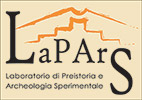Transformation and use of plant materials
The Sardinian climate and the character of the island's prehistoric remains have combined to leave no first hand archaeological evidence of the use of plant materials in the construction of buildings, furnishings, ornaments and tools, thereby shedding little light on an important component in the understanding of the economic and domestic structure of these ancient communities.
Information gathered on an ethnographic level and through experimental archaeology make it possible to approach the archaeological evidence that we already possess, which chiefly consists of the outlines of architectonic elements of funerary contexts, plant and wattle imprints on fragments of daub and clay, twine imprints on pottery fragments, paleo-botanical data and paleo-environmental reconstructions, with increased awareness, as well as illuminating that which will be gathered in the future. In other ways the absence of tangible evidence can itself become an indicator: for example, the development of significant settlements near ponds, lakes and coastal lagoons, notwithstanding the scarcity of stone or bone resources for the realisation of fishing instruments, set against the possibility, documented ethnographically, that this activity was practised in the lakes and lagoons of Sardinia, appears to demonstrate that all the necessary equipment for both active and passive fishing could be made entirely from plant materials.
Research on the prehistoric population of the areas surrounding the two most important humid regions of Sardinia, the Cagliari hinterland and the Gulf of Oristano, has highlighted the profound interaction between man and natural resources. Among the plant species traditionally used on a local level were grasses (carex), reeds, rushes, sedges, asphodelus and olive.
The information resulting from the settlement at Selargius and other locations are evidence of the use of plant materials in building, in the production of wicker, in spinning and in weaving.
